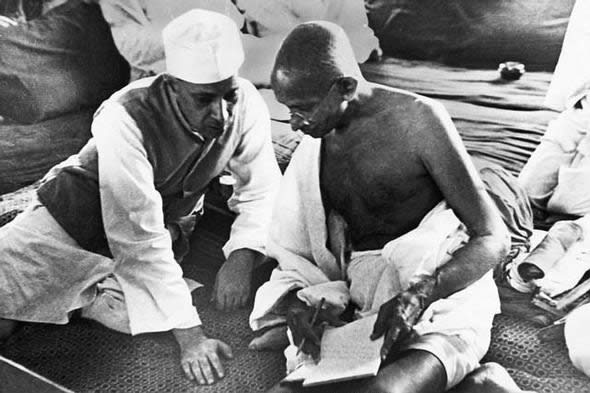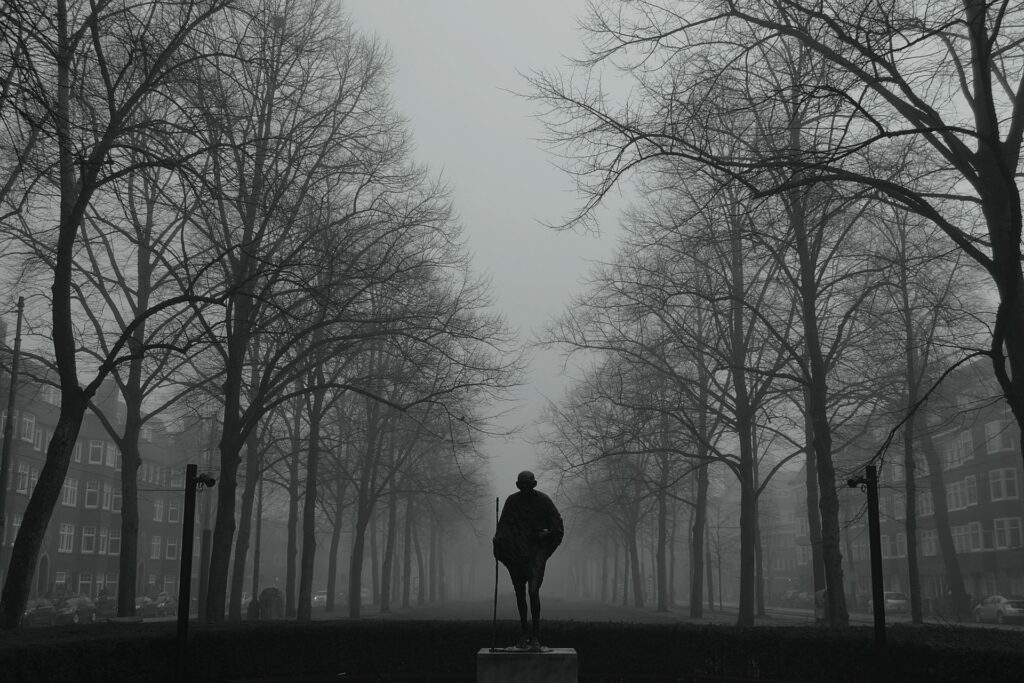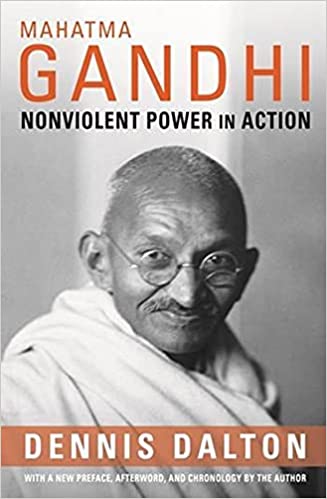Most of what I knew about Gandhi came from the biographical film produced in 1982.
I also knew his philosophy inspired people like Martin Luther King, Nelson Mandela, and even Wael Ghonim, one of the main protagonists of the Egyptian revolution.
At first, I was attracted to Gandhi to know more about how he dealt with the Hindu-Muslim conflict.
Dennis Dalton’s book — Nonviolent Power in Action — answered some of my questions and even more.
The book tackles Gandhi’s life from different perspectives making it a balanced analysis.
It goes over Gandhi’s story before he became the Mahatma, how he evolved as a person, the origins of his unshakeable belief in nonviolence, inclusive leadership, the critiques of his contemporaries, the strengths and weaknesses of his method, his views on the Holocaust, and much more.
The last chapter is the cherry on the cake. The author derives some unique insights from comparing the lives of Gandhi, Martin Luther King, and Malcolm X.
If the topic interests you, grab a copy of the book. There’s so much I didn’t cover here.
About the Author
Denis Dalton is a professor of political science from the United States. He taught at Columbia University.
His work focuses on Gandhi’s thought and leadership as well as civil disobedience.
The bibliography of this book is impressive. One that comes often is the Collected Works of Mahatma Gandhi (CWMG).
The Book in 3 Sentences
1. The non-violent method trusts the opponent’s capability to change.
2. The non-violent method is very demanding on its users.
3. Its success depends on the opponent and the faith of its users.
Impressions
This book didn’t leave me indifferent.
I went through different emotions as I was reading it. Sometimes in awe, other times sad.
In awe, because the non-violent method is a wonderful weapon for fighting injustice and resolving tough conflicts.
Sad, because the vision of Gandhi didn’t happen. Hindus and Muslims ended up killing each other.
When you add political ambitions to religious differences, the mix becomes explosive.
And the religions that are supposed to elevate the human race, end up bringing all their ugliness to the surface.
As Gandhi said in one of his last prayer meetings:
“In the name of religion, we have become irreligious.”
My Top 3 Quotes
“The outward freedom therefore that we shall attain will only be in exact proportion to the inward freedom to which we may have grown at a given moment.” [CWMG]
“The belief that there is no connection between the means and the end is a great mistake. Through that mistake, even men who have been considered religious have committed grievous crimes. …there is just the same inviolable connection between the means and the end as there is between the seed and the tree. …We reap exactly as we sow.” [Hind Swaraj]
“Religion in the highest sense of the term. It includes Hinduism, Islam, Christianity, etc., but is superior to them all. You may recognize it by the name of Truth, not the honesty of experience, but the living Truth that pervades everything and will survive all destruction and all transformation.” [CWMG]
My Thoughts After Reading the Book
The non-violent method applies first and foremost to the hearts of the people using it.
For this method to reach its full potential, the hearts of its users need to be on the same page.
But this is an almost impossible task.
All of us are at different stages of our personal and spiritual development.
Synchronizing the hearts is beyond the capabilities of any human.
That’s why when civil war broke up in different parts of British India, Gandhi felt that he failed his mission.
To his defense, his standards were high.
When you fail at his level, you still achieve something great and be remembered as the Mahatma (The Great Soul).
The synchronization of the hearts reminded me of a verse in the Quran:
“It was He who strengthened you with His help, and with the believers, and brought their hearts together. Even if you had given away everything in the earth you could not have done this, but God brought them together: God has the power to decide.” [Quran 8:63]
No matter how skilled is a leader, the union of the hearts happens only by divine intervention.
So whenever that happens, we must acknowledge God’s favors on His creatures.
Some of My Personal Notes
The Foundations of Gandhi’s Nonviolent Method
There are two concepts behind Gandhi’s method: swaraj and satyagraha.
Swaraj
Swaraj means the external freedom of political independence.
But Gandhi infused more meaning into this word by linking to the ancient Hindu idea of spiritual liberation.
Swaraj became also a quest for internal freedom—freedom from illusion, fear, and ignorance.
To attain swaraj —both internal and external— one needs knowledge of the self and thus, self-mastery.
Satyagraha
Gandhi made up this word by joining the Sanskrit satya (truth) with agraha (holding firmly).
Satyagraha is the nonviolent power born from truth.
Gandhi believed in Truth as God.
He wrote about truth in these terms:
“Truth resides in every human heart, and one has to search for it there, and to be guided by truth as one sees it. But no one has a right to coerce others to act according to his own view of truth.” [CWMG]
Satyagraha is then the means to realize swaraj.
The Difference Between Swaraj and Independence
For Gandhi, independence was negative while Swaraj was positive:
“The root meaning of swaraj is self-rule. Swaraj may, therefore, be rendered as discipline rule from within…’Independence’ has no such limitation. Independence may mean license to do as you like. Swaraj is positive. Independence is negative. …The word swaraj is a sacred word, a Vedic word, meaning self-rule and self-restraint, and not freedom from all restraint which ‘independence’ often means.” [CWMG]
The Difference Between Satyagraha and Passive Resistance
Passive resistance generates internal violence.
Even if physical violence is not used, resisters develop enmity and anger.
For Gandhi, “Satyagraha is gentle, it never wounds. It must not be the result of anger or malice.” [CWMG)]
Gandhi: The Innovator of Swaraj
Here are the 3 novel ways he shaped the concept of swaraj:
1-He connected ahimsa to swaraj through satyagraha
Ahimsa (not violent) is an ancient Indian idea. It induced that harming others was equivalent to injuring oneself.
He made nonviolence a must to attain independence.
2-He declared that collective swaraj is impossible without the individual one.
Swaraj depends on the individual dimension.
It’s a pilgrimage towards self-realization.
Without a minimum of awakened individual conscience, swaraj can’t be attained.
3-He defined the concrete manifestations of attaining swaraj
Gandhi connected India’s freedom to three social reforms.
The Indian society has to overcome three major problems: Hindu-Muslim religious conflicts, the evils of casts and untouchability, and economic inequality.
What South Africa Did to Gandhi
Until the age of 37 (1906), Gandhi’s ideology relied and depended upon Western concepts and values to the exclusion of anything Indian.
In response to the inflexible racist authority, Gandhi shifted from emulating the West to rejecting it.
At first, he became exclusive. Then, later on, he transformed into an inclusive leader.
Emulation, rejection, and inclusion are the same stages of personal development Malcolm X went through.
South Africa was a land of experiences and ideas elaboration.
Being thrown off a train awakened his motivation to fight racism.
Witnessing the Zulu massacre impacted him profoundly. Since then, he took the path of self-discipline starting with a vow of celibacy (brahmacharya).
He went in and out of prison multiple times. He was nearly killed by his own Indian community.
During this South African period, he also wrote Hind Swaraj — his classic treatise proclaiming Indian independence.
There, he also established his first ashrams to train civil resisters. He also had the chance to test civil disobedience.
After 21 years in South Africa, he returned to India with valuable luggage of ideas and practical experience.
Books That Influenced Gandhi
When he was a law student in London, he studied the Bhagavad Gita (his primary text of Hinduism) and discovered The Sermon on the Mount (a collection of teaching attributed to Jesus).
In his autobiography, Gandhi said that Tolstoy’s book —The Kingdom of God Is Within You— overwhelmed him.
John Ruskin’s Unto This Last also influenced him. He translated it in Gujarati under the title of Sarvodaya (Well Being of All).
The Exclusivist Phase
To emancipate from Western concepts, he coined the word satyagraha, a word that didn’t exist before:
“To respect our own language, speak it well and use in it as few foreign words as possible.” [CWMG]
In Hind Swaraj, he wrote that Indians can’t achieve swaraj by imitating the Western example. They must construct a civilization on the simple ethical and religious truths found in their own tradition.
In his treatise, India rhymes with good and the West with evil.
India is moral, uses soul force, and it’s based on the belief in God. The West is immoral, uses brute force, and it’s godless.
It took him 10 years to become an inclusive leader, which will become his political signature.
The Essence of Gandhi’s Teachings

Jawaharlal Nehru served as India’s prime minister for 17 years.
Here’s his testimonial on Gandhi’s achievements:
“He was like a whirlwind that upset many things but most of all the working of people’s mind… Much that he said we only partially accepted or sometimes did not accept at all. But all this was secondary. The essence of his teaching was fearlessness and truth and action allied to these, always keeping the welfare of the masses in view.
[…] It was against this all-pervading fear that Gandhi’s quiet and determined voice was raised: Be not afraid. So, suddenly, as it were, that black pall of fear was lifted from the people’s shoulders, not wholly, of course, but to an amazing degree.As fear is a close companion to falsehood, so truth follows fearlessness. It was a psychological change, almost as if some expert in psychoanalytical method had probed deep into the patient’s past, found out the origins of his complexes, exposed them to his view and thus rid him of that burden.”
The Salt Satyagraha
On March 12, 1930, Gandhi (60 yo), left his ashram at Sabarmati with seventy-eight followers.
He was heading to the shores of Dandi, a small village in Gujarat, western India.
The march lasted 24 days and covered about 320 km.
The goal was to protest against the tax the British Raj had placed on salt.
Gandhi defied the monopoly enforced by the government.
He broke the law by simply collecting natural salt from the seashore.
The Salt March was about empowerment. It told people that they were stronger than they thought and that the rulers were weaker than they imagined.
After Gandhi’s act, many followed his example throughout India. It intensified with his arrest. The movement continued for almost a year until the negotiations started.
The Strengths of Satyagraha
It’s an inclusive weapon:
“Nonviolence made it possible for a larger number of women to participate. In fact, Gandhi’s nonviolence was powerful revolutionary weapon because it created a favorable atmosphere for participation of a very large number of people, especially women, giving them all a meaningful place in the struggle.”
Moreover, it creates ambivalence in the adversary.
The Britons were given no opportunity to justify the use of violence.
Also, they would never resolve the dilemma of how to handle the women.
More, British police were in extreme distress when dealing with the civil disobedience movement. They felt they were doing something wrong.
In sum, satyagraha empowers the weak and changes the strong.
Violence is replaced by self-sacrifice.
Self-sacrifice fuels the soul force that goes and defies brute force.
The whole process requires personal suffering, which leads to self-realization, and thus, to attain swaraj.
Why Inclusiveness Didn’t Work?
Despite his inclusive approach, Gandhi failed in uniting India.
Among other reasons was his leadership.
The Hindu style of his thought and action was a strength to appeal to Hindus, but a weakness to attract Muslims.
All they could hear is a Hindu raj would perpetually dominate them.
The fear of being second-class citizens built up.
Gandhi lost the support of Muslims with the Salt March. But he will gain their trust later on during the civil war.
For him, the civil war was a personal failure. He took it as a sign that he misused satyagraha.
By his own standards, India didn’t attain swaraj.
Nevertheless, when things started getting tough, Gandhi put his life on the line to defend his inclusive vision.
Fasting: The Ultimate Weapon
Gandhi said about fasting:
“My religion teaches me that whenever there is distress which one cannot remove, one must fast and pray.”
And distress will fall upon India between 1946 and 1948.
In the context of the partition of British India into Pakistan and India, civil war broke up.
The Great Calcutta Killing was a notorious event. In just 4 days, about 4000 people were killed and 11000 injured.
From there, it spread to Dacca, Noakhali, Bihar, and Punjab.
While politicians blamed each other or expressed their feelings of pain, Gandhi was at the front line.
He visited the devastated areas, consoled the afflicted families, and stood by the oppressed.
He sided with both Hindus and Muslims depending on who suffered the most from violence.
In Calcutta, he tried fasting as the ultimate weapon for conflict resolution.
When he began his fast, Gandhi declared he will end it only if sanity returns to Calcutta.
Three days later, the mass therapy worked.
His suffering, while his not responsible for the killings, disturbed people and released positive energies.
Hindus and Muslims promised to reconcile their differences.
The victory over the evil in Calcutta is probably one of his biggest achievements.
The Mahatma More Powerful in Death Than in Life

January 1948 was the month of his assassination.
He fasted in Delhi this time for communal peace. It lasted six days and ended up in success.
But he enraged some Hindus by his efforts to protect the Muslims.
On January 30, Gandhi was assassinated on the way to prayers.
His killer unapologetically declared that his motive was Gandhi’s tolerance to Muslims.
Gandhi’s death at the hands of a Hindu fanatic stopped the communal violence surrounding partition.
The policy of revenge was abandoned. The Hindu extremists were discredited.
The Mahatma was even more powerful in death than in life.
Humayun Kabir, a prominent Indian Muslim politician said:
“His assassination had a cathartic effect and throughout India, men realized with a shock the depth to which hatred and discord had dragged them. The Indian nation turned back from the brink of the abyss and millions blessed the memory of the man who had made redemption possible.”
Gandhi’s Views on the Holocaust
Gandhi had an unshakeable belief in his nonviolent method.
He said that even if a Jewish Gandhi could function only for five minutes, that wouldn’t shake his belief in ahimsa.
In 1946, he gave his verdict on the Holocaust:
“Hitler killed five million Jews. It’s the greatest crime of our time. But the Jews should have offered themselves to the butcher’s knife. They should have thrown themselves into the sea from cliffs…It would have aroused the world and the people of Germany…As it is they succumbed anyway in their millions.”
The strength of Gandhi is turning ideas into actions. But in the case of the Jews, he was unable to give practical solutions.
It shows that leaders need to be familiar with the context before offering solutions.
There are at least three differences between British India and Nazi Germany:
- While you could appeal to conscience in Britons, it wasn’t possible with the Nazis.
- Jews had no access to national media to promote their cause.
- Jews were a small minority. Their resistance, violent or nonviolent, depends also on the non-Jews.
It seems that satyagraha doesn’t work with dictators ready to kill millions!
Article published: February 5, 2022
Popular Articles
- 7 Lessons from Luqman that Will Make You Wise
- How to Enjoy Salat and Make it Meaningful
- Mongols Invasions: Some Forgotten Lessons to Today’s Muslims
- For or Against Vaccines? That’s Not Really the Question
- Are Muslims Meant to Be Sleep Deprived?
- Islamic Psychology: A Model Where Faith Has Its Place
- Muslims Judging Each Other: Why and How to Be Less Judgy
- The Value of Time
- 3 Tips to Unlock the Believer Mindset
- The Certainties of Muslims in Uncertain World
- Allah According to Allah: The Beauty Behind the Verse of Light
- How to Make People Change their Mind: Persuasion!
- 5 Powerful Duas from the Quran to Help You in Both Worlds

